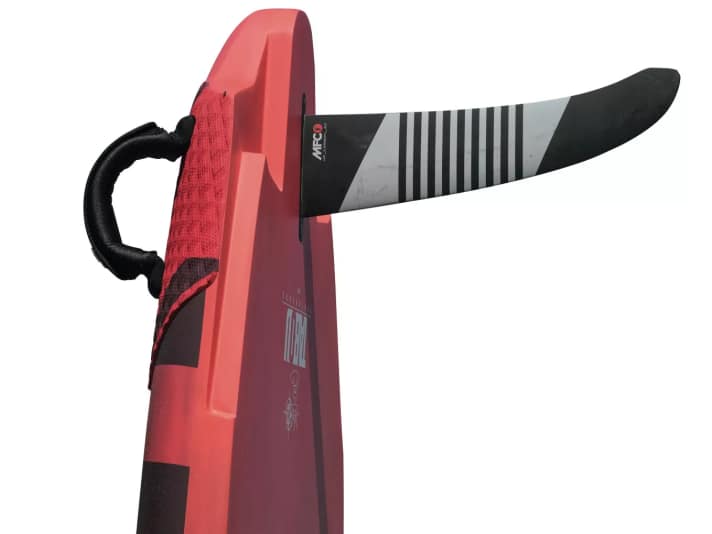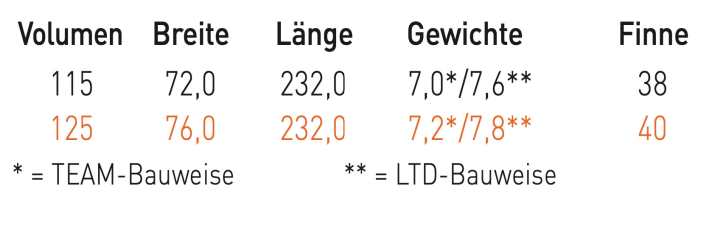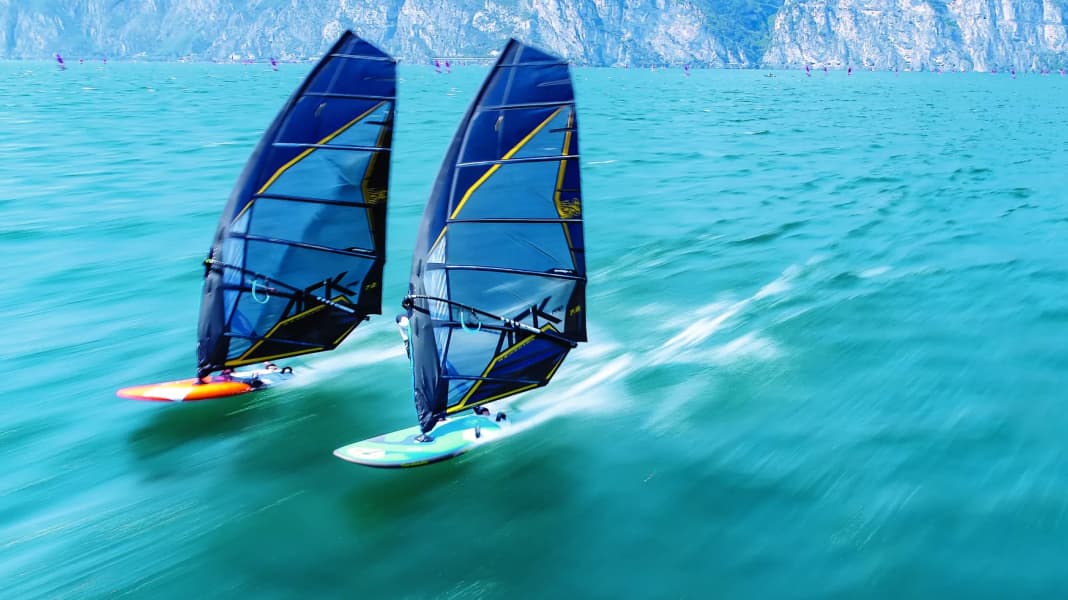
You are only really fast if you have everything under control. So it's hardly surprising that almost all the freerace boards in this test group are very easy to control. A Goya Bolt surfs as easily as a freeride board and even the Tabou Rocket+ and Fanatic Jag shapes, which were previously considered to be a little more demanding, seem really easy to control in a wide wind window. "Don't be afraid of freerace boards" could therefore be the motto, but at least the strap positions still need to be labelled with a little warning. This is because the inner row of dowels is also intended more for experienced windsurfers, while the outer row can be categorised as very sporty almost across the board.
It was particularly difficult for this test to put together a group that was absolutely harmonious in terms of size. On the one hand, the manufacturers still rely on very different shape concepts in terms of the ratio of width to volume. On the other hand, the freerace boards on offer are still graded very differently in the available sizes. If you compare the "key data" of the Starboard Futura and RRD Fire Storm, for example, this is easy to see. While Starboard thins out the Futura to 117 litres with a width of 77 centimetres, the Fire Storm offers a generous 135 litres of volume despite being only 75 centimetres wide. If you want to compare boards from different brands, the width is probably the decisive factor, with a few exceptions.
We tested these 8 freerace boards:
(Click on the name to go to the respective test board)
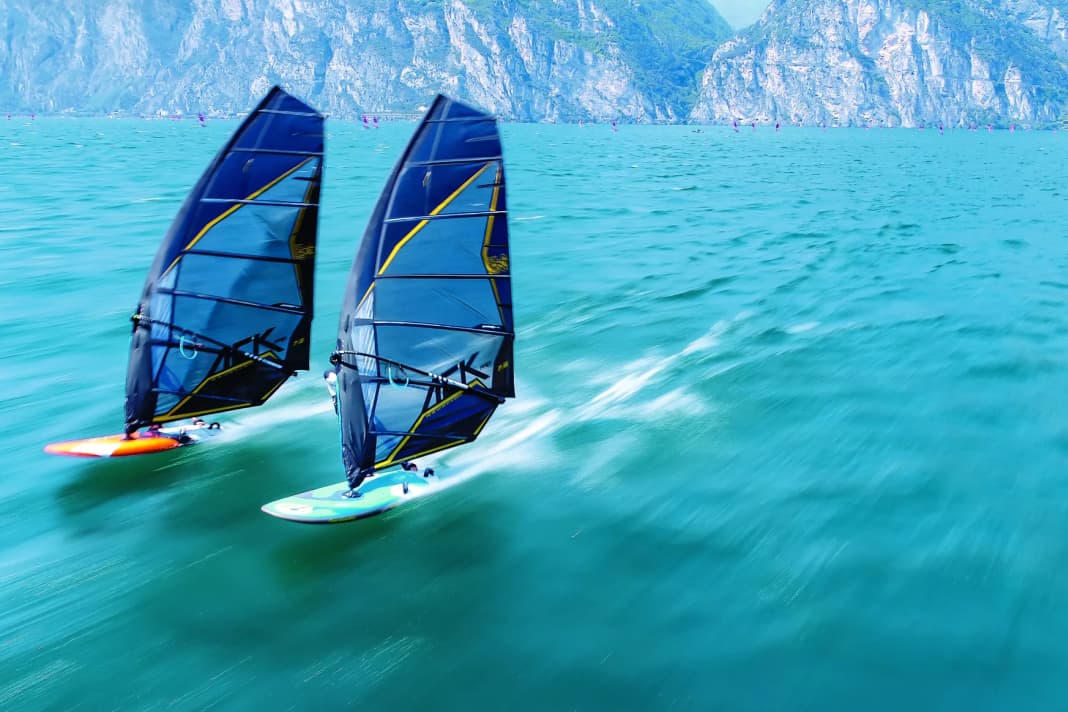





Width is the more important currency for freerace boards
For heavier surfers, over 90 or 95 kilos for example, it naturally plays a role whether 117 or 135 litres are carried when planing and turning. Once planing, the overall width and the tail width become much more important. Freerace boards with the same width are easier to compare in terms of range of use and suitable sail sizes than freerace boards with the same volume. But even then it remains difficult to put together a standardised field. If you take 78 centimetres as the average for this group, JP only has the choice of a smaller model in terms of width and also volume (122/77) or otherwise, with 133/82, the almost largest model in terms of volume and width in the test.
At the end of the test, the group is actually divided into two subgroups: One is the freerace boards, which should rather carry the 7.8cm sail as a lower size. These are Fanatic, Goya and Patrik, which form a class of their own not only because of their overall width of around 80 centimetres and more, but also because of their comparatively wide tails. The remaining five candidates make up the second group, for which 7.8 square metres should be pretty much an average, well-suited sail size. With widths of 75 to 77 centimetres, these shapes - apart from the very special Tabou Fifty - also feature somewhat slimmer stern shapes.
The freerace boards on land
A trend from the racing sector has also become established here - from the mast track at the latest, the board becomes progressively thinner towards the nose. This hardly has any disadvantages with the large-volume freerace boards, but with the rather narrow-chested Starboard Futura with its slim 117 litres, this requires nimble feet when turning. The underwater shapes are predominantly less spectacular and are based on a slight to medium V with predominantly very slight concaves. The most striking features were the very pronounced V at the front of the Starboard Carve and both Tabous, as well as the planing surfaces that are around 10 centimetres longer than usual on the Tabou Rocket+ and Goya Bolt. The almost flat planing area at the rear of the RRD and the particularly deep and large cut-outs explain part of the RRD's riding characteristics.
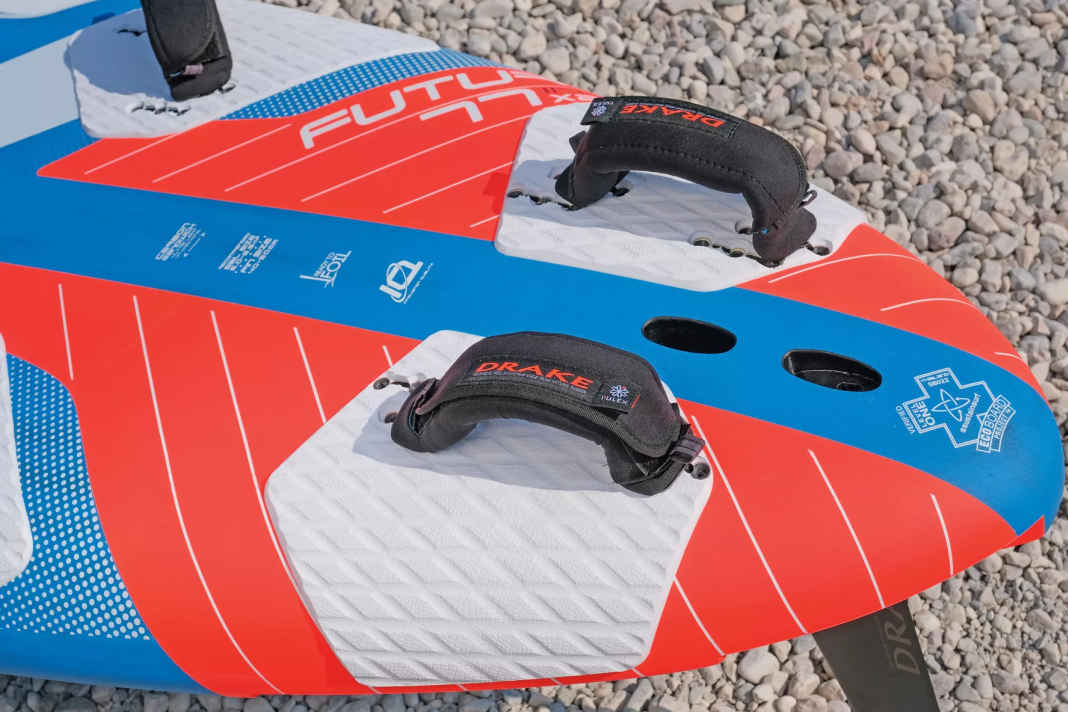





The freerace boards on the water
Well-known names showed up in the test with some noticeably revised characteristics.
The Fanatic and Rocket+ have been tamed down a little and still offer a lot of speed in medium winds, but now have a much smoother planing behaviour. At top speed, both are still at a somewhat more demanding level with still very sporty demands at the limits, but without the really stressful thrills. The boards from Goya and Patrik, on the other hand, are almost really leisurely and the JP board also ensures calmness on board in almost every situation. Among the Tabou twins, the foil-fin hybrid is much more demanding.
The power density of freerace boards is damn close
While the wider boards can, as expected, play to their strengths in planing - which is also noticeable through good upwind performance - the fin configuration tends to play into the hands of freerace boards with small fins at top speed. With a 48 mm fin like in the Patrik F-Race, the limit is simply reached a little earlier than with a 44 mm fin in the RRD Fire Storm. But even freerace boards like the Goya Bolt keep up well with the right pressure in a 7.8 mm sail. However, RRD, JP and Starboard are still a touch faster and easier to surf. In the planing disciplines, however, at least RRD and Starboard are not among the absolute favourites. Starboard fires up a little later in passive planing, the RRD tends to lose a little to the wider freerace boards in planing winds on the edge of parking - but it quickly makes up for this in normal use.
Manoeuvres with freerace boards
The jibing characteristics are consistently decent, even good with Tabou Rocket+ and JP. However, if you value variable jibes with little pressure, you should consider looking in the freeride class. Despite their very wide tails, these shapes are easy to jibe - even the wide Goya has a nice, medium radius with good planing potential, Patrik also planes variably through the turn in normal jibes and the RRD Fire Storm is particularly easy to initiate and cuts through choppy water well - but the power jibe is still not the showpiece discipline in this board class.
Foil excursion
If the freerace boards already offer the option, we should also try it out - in short: all test boards are suitable for foiling. With the same 7.8 mm sail as for our fin rides, we flew across the lake at 10 knots. In comparison to a pure foil board, the boards started noticeably more abruptly. All in all, the simple formula was confirmed: The shorter and wider a board is and the further apart the two tail straps are, the more stable the foil flight becomes. This means that all the boards in this group are quite suitable, but the Tabou Fifty is actually a touch better. But Fanatic and Patrik also offer particularly suitable proportions, while the Goya board is already very long for foiling. However, the freerace boards do not come close to the special feeling of a foiling specialist that is perhaps only 2.10 metres long. Incidentally, we tested all models with the "GA HP 1150" foil.






Fanatic Jag 135 LTD
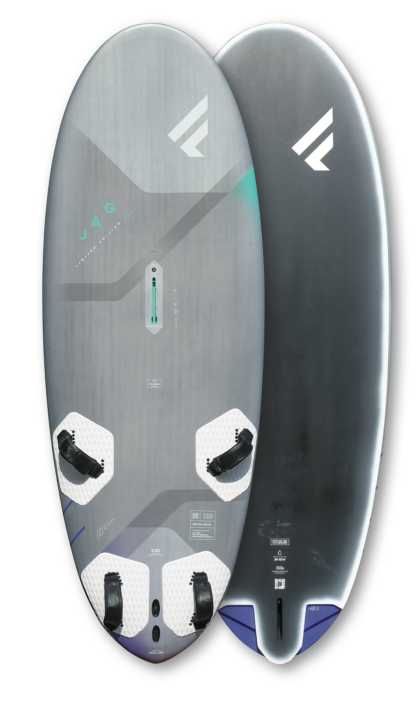
Since the last test, the previously quite demanding Jag has obviously changed noticeably. Even though the board is one of the largest in this group, it offers a very stable planing position in a wide wind window. The wide, thin board glides very freely, but without nervous flying and has hardly any water contact in choppy water. The board requires more body tension than Patrik or Goya, but actually "flies" surprisingly smoothly over the waves. The board not only planes well, but also achieves very good speed in light and medium winds with excellent planing potential in wind holes. The deck shape under the straps is less angular than on a slalom plane and is sporty but comfortable even for longer strokes. At top speed, the 46 mm fin minimally reduces the potential, then the board also becomes more demanding. On the other hand, the Jag also handles much larger cloths than 7.8 very well. In the jibe, the board planes very well, only in tight turns in steep chop does the board's width become a little annoying - not a shape problem, but merely the influence of the comparatively large width.
Conclusion:A sporty board, especially for light to medium winds.
Price:2299 Euro
surf measurement:Weight: 8.3 kg
Info: Boards & More GmbH Tel.: 089/666550
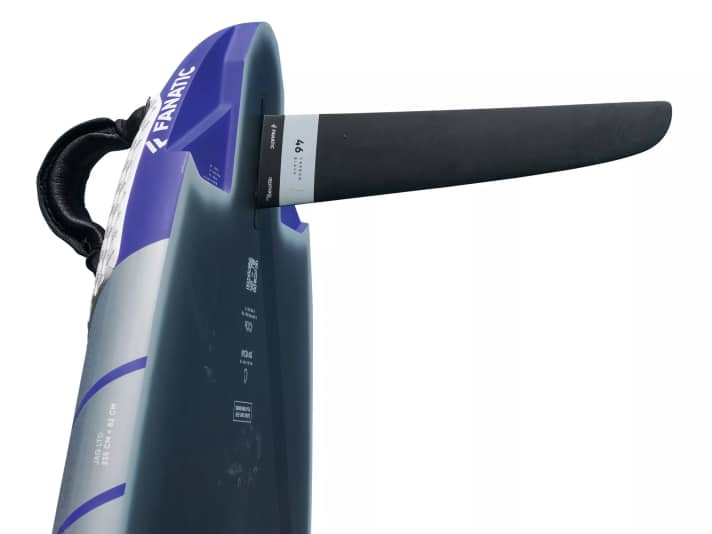
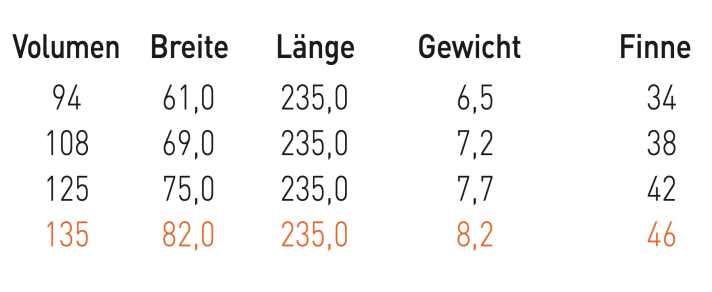

Goya Bolt 137 Pro
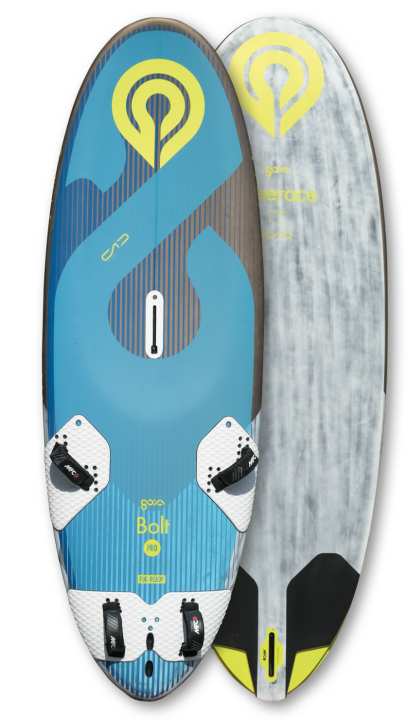
"Like a train travelling inexorably straight ahead", is how one tester characterised the Goya board. In fact, the board planes particularly well and easily and then holds a stable course when fully planing - free over the chop, but as steady as concrete around the longitudinal axis. This makes it particularly easy to concentrate on the sail and elicit maximum performance from the board. And the good 46 mm fin ensures that the Goya has nothing to hide in the speed duel, especially in the lower and medium wind range. When the wind drops a little, the Bolt stays planing for a particularly long time. The Bolt is one of the larger-looking shapes in this group and relies on a very striking volume distribution. The bow area is heavily thinned out with a deep trough and the tail is not only thick, but also "domed", i.e. more arched. The shape combines powerful, fat box rails in the tail with a neatly rounded stance position in the straps. For maximum top speed, you have to put more physical effort into the board. This also applies to power jibes, which require a lot of pressure and guidance and are somewhat limited in radius.
Conclusion: Sporty early glider with freeride suitability.
Price:2150 Euro
surf measurement:Weight: 7.84 kg
Info: TPE Sport Distribution , Tel. 0461/9789560
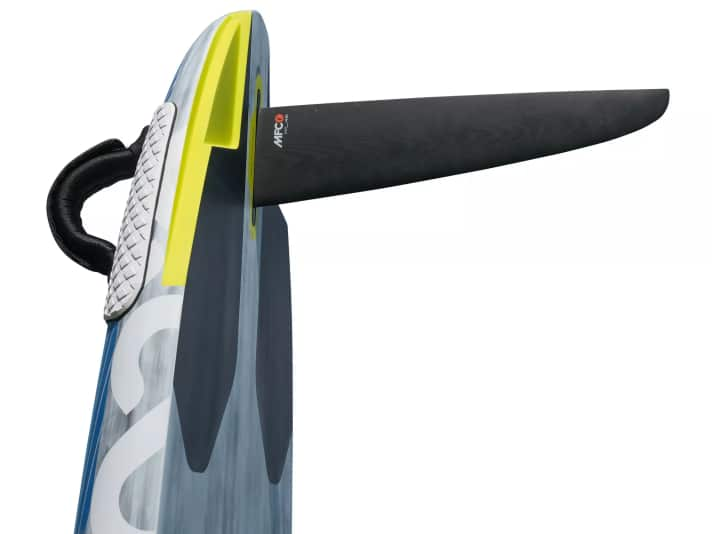
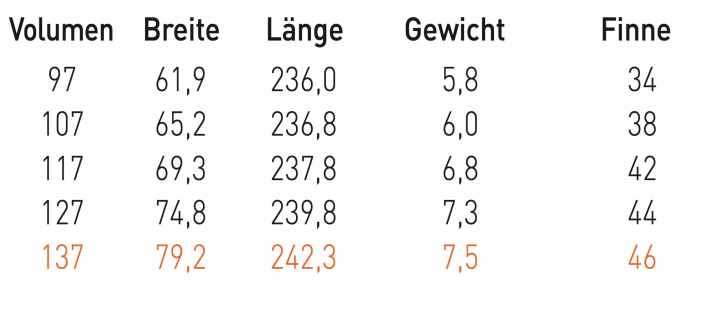

JP-Australia Super Sport 122 LXT
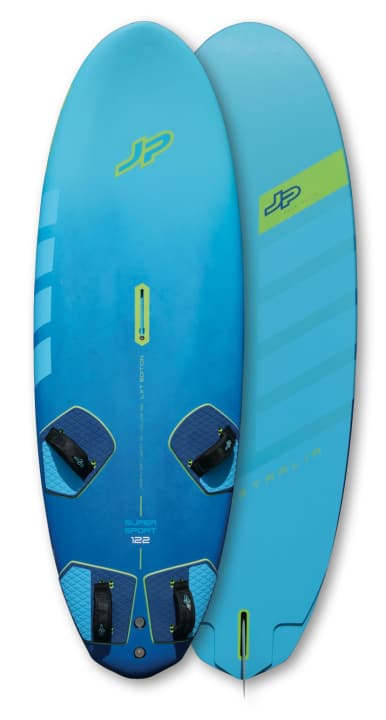
With 122 litres and a width of 76 centimetres, the Super Sport is not only the smallest board in the group on paper. The board feels particularly at home with the 7.8 mm sail, a large 8.6 mm certainly marks the upper limit of what is sensible to use on the board, the 44 mm fin also harmonises with the 7.8 mm. Typical for the Super Sport is the particularly comfortable stance and the very good controllability, even if the standard fin requires a slightly finer load. The board surfs almost like a sporty freeride board. It flies freely, but not fidgety, and still reacts well to steering impulses.
impulses, making it somewhat more agile than the wider and larger Goya or Patrik shapes when required. The "stance", i.e. the step width in the loops, is a shade narrower than in the centre. The narrower tail with less volume also has a positive effect, especially in jibes; the board requires comparatively less foot pressure and turns quite tightly. It glides easily and smoothly through the turn, even if you have to cross small choppy waves in the turn.
ConclusionVery fast freerace board with the lowest stress level.
Price:2299 Euro
surf measurement:Weight: 8.2 kg
Info: Pryde Group GmbH , Tel.: 089/6650490
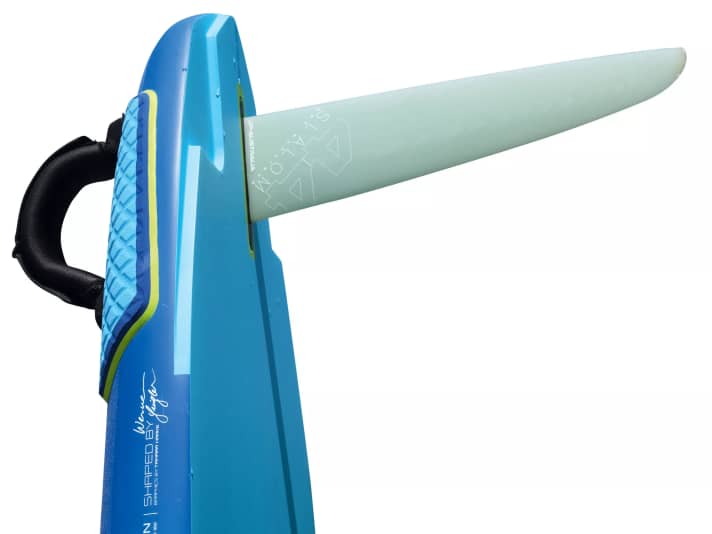
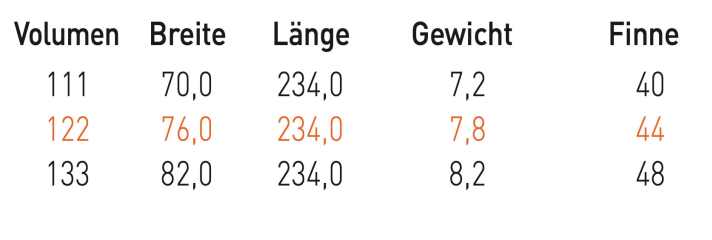

Patrik F-Race 140
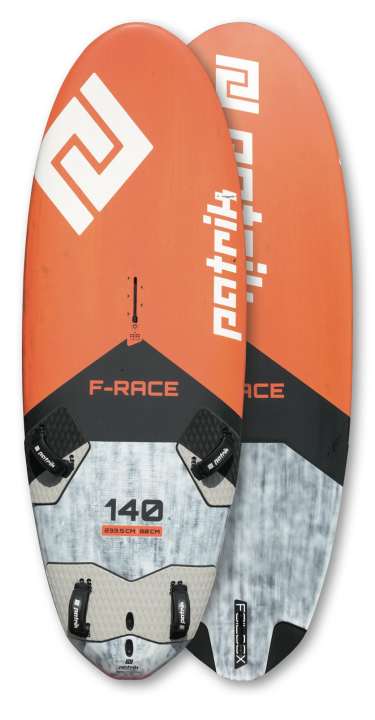
With the Patrik F-Race, the next smaller size would probably have fitted into the test as well, then it would have been the narrowest board in the group. As it is, the 140 is at the upper end of the scale and the board almost looks like a small Formula board in comparison. Despite the large 48 mm fin, the F-Race glides freely but still quite flat over choppy water and is even more stable in the air than the Goya. Even without a lot of body tension, the board stabilises itself almost automatically and becomes very fast in the lower and medium planing wind range without any major tricks. The price is the hardly agile riding behaviour, the board hangs very "curled" on the foot. Occasionally a smaller wave is touched, but it is almost impossible for the nose to rise into the sky unintentionally and the board hardly rolls at all around the longitudinal axis, which conveys a great deal of safety. The board glides through the jibe surprisingly smoothly and with very little pressure, completely ignoring chop. Even quite tight radii can be channelled into the water with the wide tail.
ConclusionVery inherently stable glider for heavier surfers and sails ideally from eight square metres, which jibes surprisingly well.
Price:2399 Euro
surf measurement:Weight: 8.2 kg
Info: Open Ocean GmbH , Tel. 07132/4024
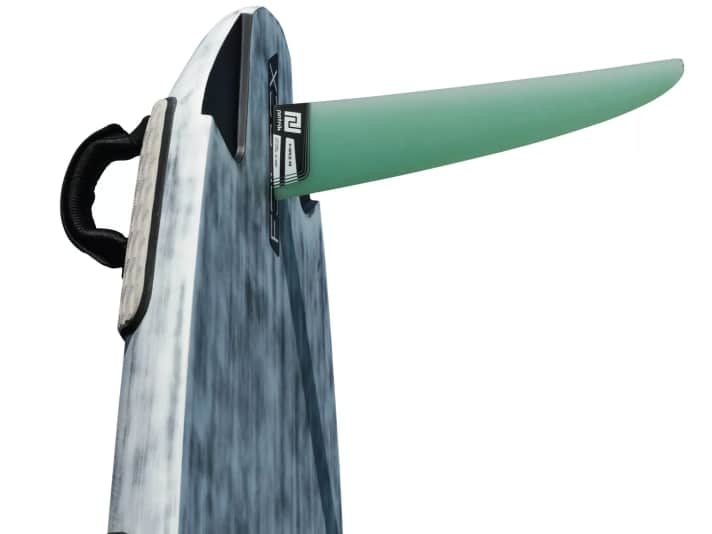
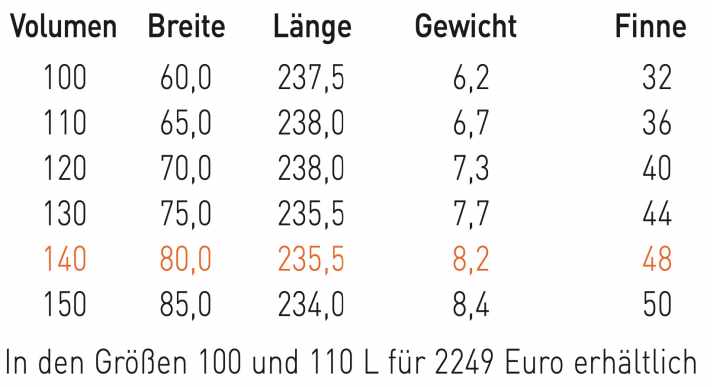

RRD Fire Storm 135 LTD
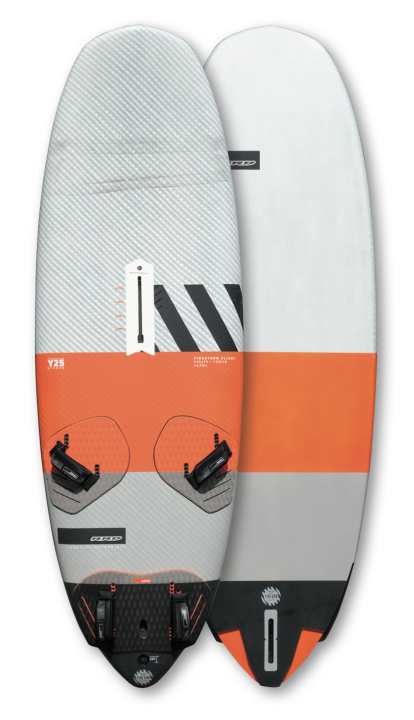
Punching downwind - that's one of the most fun things to do on the RRD. The stronger the gusts push into the sail, the more the board can play to its strengths. In very light planing winds, the RRD doesn't immediately glide super freely like other freerace boards, it occasionally comes into contact with the water in choppy water and its flat underwater hull gives it a sporty, crisp planing position. When the wind picks up, the board can accelerate in every gust on the slightly shorter planing surface and the deep, large cut-outs in the tail, then flies freely and without further ground contact over the fin and still feels very controllable and secure on the foot. The board rolls easily around the longitudinal axis, is agile and very direct. The stance in the outside backstrap is like on a slalom board for maximum performance on the somewhat "boxy" rail, with pithy feedback under the soles. The board also jibes with less foot pressure, runs smoothly on the rail through choppy waves, the gliding characteristics are not outstanding compared to the best, but are okay.
ConclusionA sporty board that offers the best top speed with easy controllability.
Prices: 2699 (LTD)/2299 (LTE) Euro
surf measurement:Weight: 8.5 kg
Info: Pryde Group GmbH , Tel.: 089/6650490
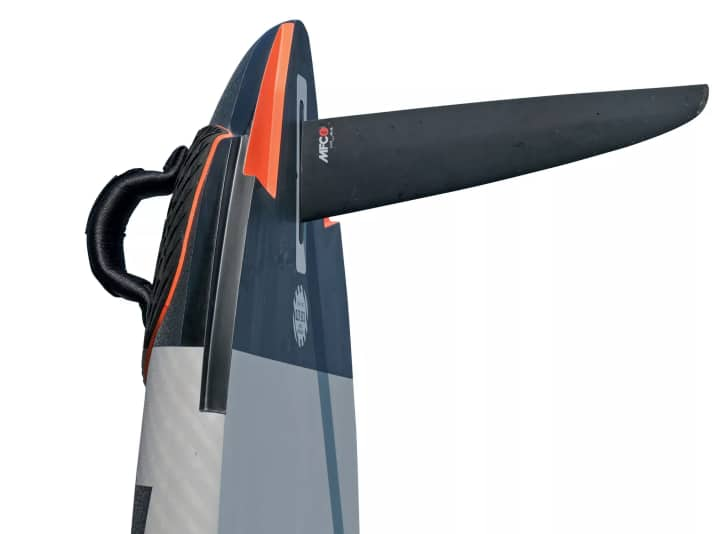
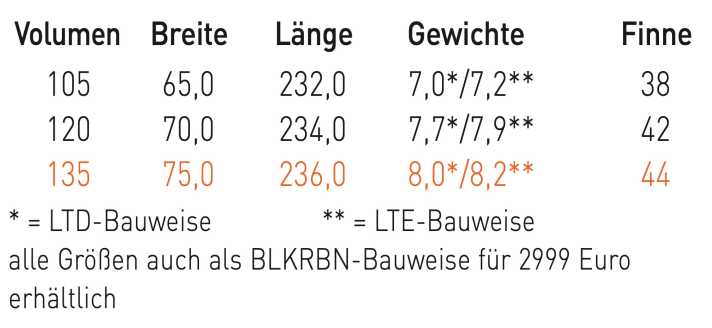

Starboard Futura 77 Carbon
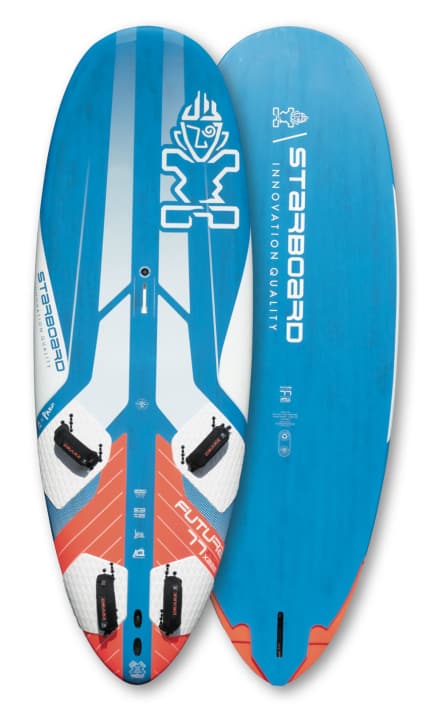
The Futura is not dissimilar to its half-brother, the freeride board Carve, in terms of its characteristics. The short board with the rather steep transition from the flat planing surface to the nose is slightly delayed when planing, but then it accelerates vehemently and achieves top results in speed comparisons across the entire wind range. It hangs damped and super easy to control at the feet, flies high over every chop. The standing position is comfortable, but for real slalom racers there should be a row of holes further out, especially at the front. The tail is narrow, but probably due to the large thickness it still looks very beefy underfoot and can take a lot of foot pressure and sail power for maximum speed. The 42 mm fin is very well matched to the slightly narrower tail. The Futura combines top speed with comfort and safety. When jibing, medium radii in the classic power jibe technique are smooth, only when carving over the rail with a lot of planing does the board bite into the chop a little more. You should be quick when turning. All in all, the Futura impressed with the best speed and fairly easy handling.
Conclusion: Sophisticated comfort racer!
Prices: 2449 (Carbon)/2199 (Wood) Euro
surf measurement:Weight: 7.94 kg
Info: APM Marketing GmbH Tel.: 08171/387080
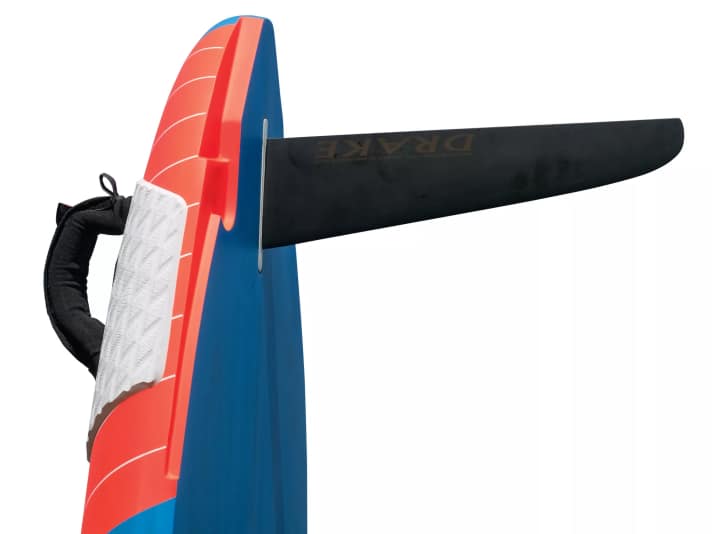


Tabou Rocket+ 123 Team
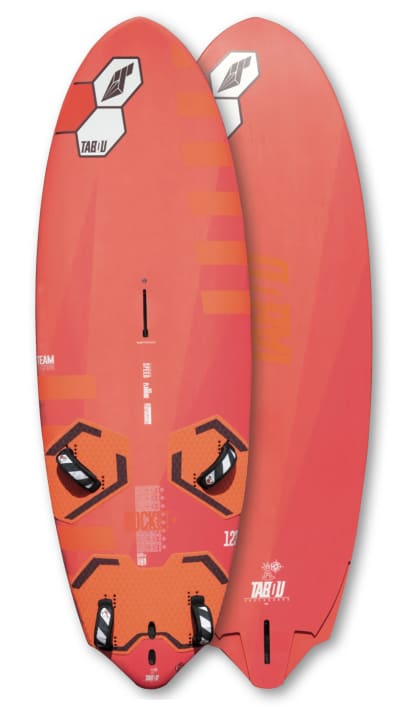
The Rocket+ definitely emerges from this comparison as the jibe champion. It certainly helps that the board is at the lower end of the scale in terms of volume. In any case, the board can be power jibed very well with little pressure, but can also be carved over the rail with the sail laid flat. In both variants, it impresses with its smooth ride, but above all with the best planing potential. In flat and choppy water, the Rocket+ almost always offers the option of really smooth jibes. But even in race mode, the board doesn't miss a beat, achieving great top speed despite the rather simple fin, even if it's not quite as easy to tame at the limit as the RRD, for example. Nevertheless, Tabou has tamed the board slightly compared to the last generation, which is very beneficial to the overall appearance. What has remained is a free glide that never really reaches the limit of being untameable. As a rocket pilot, however, you should have a little sensitivity in the tips of your toes. But then the board is a lot of fun to ride, combined with objectively super performance.
ConclusionVery good speed meets equally good jibe potential.
Prices: 2499 (Team)/2199 (LTD) Euro
surf measurement:Weight: 7.64 kg
Info: New Sports GmbH Tel.: 0223/4933400
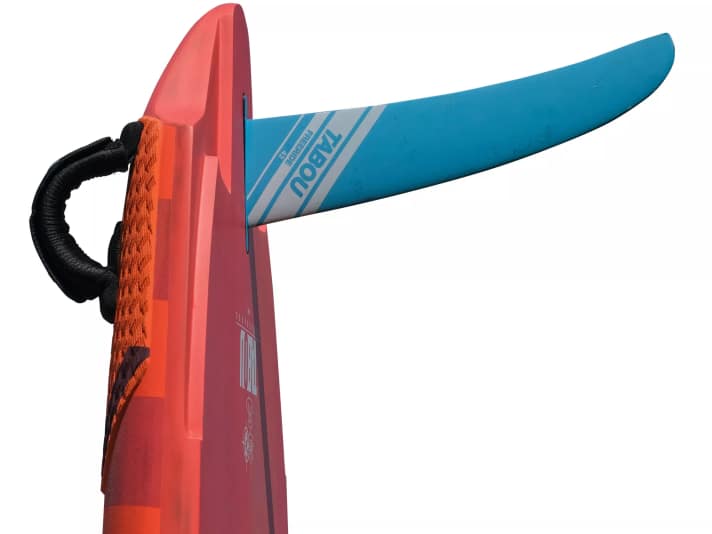


Tabou Fifty 125 Team
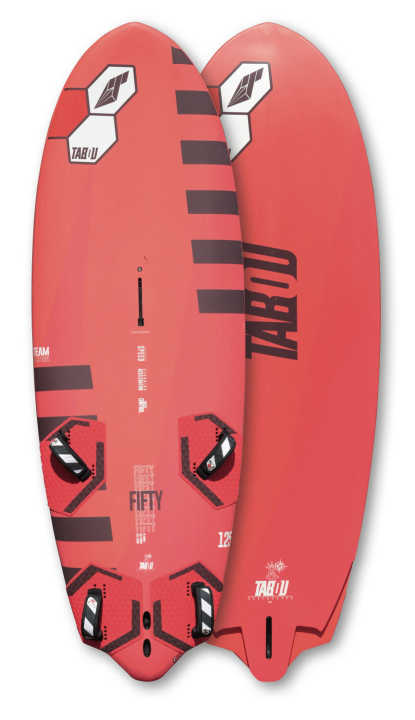
The Fifty has been optimised for foil suitability, including a wider tail and correspondingly wider distance between the two rear straps. This doesn't even seem strange when fin surfing - once you're in the straps. Getting into the straps is challenging, as is getting out of the jibe at full planing speed without letting off the throttle. Apart from that, the board is noticeably similar to the Rocket+, it is a little more demanding, glides more freely (it has a very short planing surface and the deepest cut-outs) and is more direct and pithy. It planes well, accelerates very easily and always conveys a very light, lively feeling. This is probably also due to the short 40 mm fin, which harmonised very well with the 7.8 mm test sails. Surprisingly, the board needs the most attention at top speed despite the smallest fin. Tabou has obviously already tuned this appropriately. In gybes, the Fifty is also a good glider, the wide tail requires more pressure than on the Rocket+, but can then even be carved well.
ConclusionSporty compromise for freerace and foil surfing.
Prices: 2499 (Team)/2199 (LTD) Euro
surf measurement:Weight: 7.76 kg
Info: New Sports GmbH Tel.: 0223/4933400
